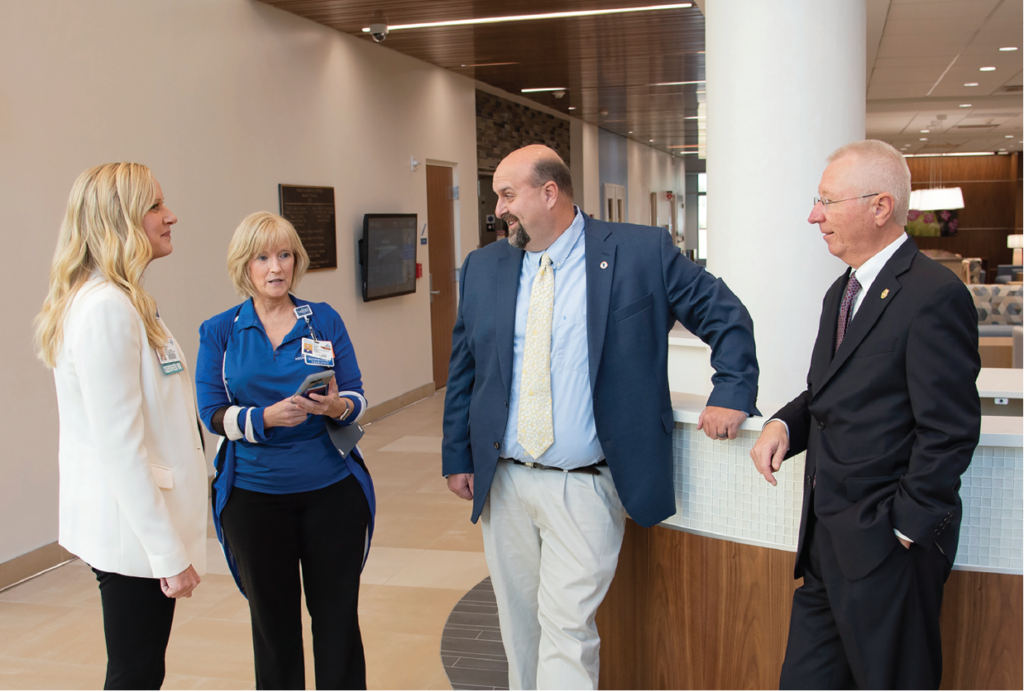Neighboring hospitals work collaboratively to help patients stay healthier
“I’m a statistics guy—I like to look at the data,” says Craig Luedeman, the mayor of the Indiana city of Seymour.
He may like data, but he definitely didn’t like what the numbers were showing with regard to healthcare expenditures. The city’s costs for insuring employees and their dependents were nearly triple what they were when he first was elected in 2007.
So he was intrigued when he heard about a partnership between the local hospital, Schneck Medical Center, and Columbus Regional Health half an hour to the north. Inspire Health Partners, formed in 2013, is a clinically integrated partnership aimed at helping patients stay healthier and, to the extent possible, steer clear of costly care.
It’s a step down the path toward value-based care, says Slade Crowder, MD, associate chief medical officer at Columbus Regional and a board member with Inspire. Value-based care rewards healthcare systems that solve the challenge of patients whose chronic illnesses run up the highest bills. “If we can lessen the patients’ illnesses, we can use fewer resources,” says Eric Fish, MD, MBA, FACOG, President and CEO of Schneck and chairman of the board for Inspire.

Getting a handle on this kind of high healthcare usage requires a lot of coordination. “Inspire has been an opportunity for us and Schneck, our neighbor, to work collaboratively rather than competitively, since we share so many patients,” Dr. Crowder explains.
The endeavor is physician-driven and physician-led, Dr. Fish says. Its work is guided by a number of committees, from primary-care leadership to quality to process improvement. Leaders establish targets for a wide range of measures that are part of prevention, such as mammograms, screening colonoscopies, immunizations for children, breast cancer screenings and tests for A1c. Predictive analytics help identify the best candidates for intervention.
Inspire also has equipped participants with the kind of change management know-how required to help new processes take hold as best practices are adopted. Primary-care offices build a patient-centered medical home approach and reorganize their work to take on a more team-focused mindset. The person at the front desk, for example, may be tasked with ensuring that patients sign up for the patient portal. Nurses can tap into new standing order sets to connect patients with mammograms. “It’s about getting the entire team together,” Dr. Crowder says.
And perhaps most important, care managers keep tabs on patients and help with warm handoffs, Dr. Crowder says. Patients admitted to the hospital may get a call from a care manager while they’re still in the hospital, arranging follow-up visits, and making sure they’ll have meds and answers to their questions.
“Historically, we’ve been an episodic business,” Dr. Fish observes. The Inspire approach hopes to provide more holistic care on the front end while “trying to avoid that catastrophic event. Ten office visits are a whole lot cheaper than one hospitalization.”
“Inspire’s data analytics allow our providers to identify at-risk patient populations and be proactive in the provision of their care, while at the same time emphasizing preventive care for all of our patients,” says Warren Forgey, Schneck’s former president and CEO. “Inspire’s seamless design is improving the health of our patients, delivering a better patient experience, and is beginning to reduce the overall cost of care.”
Indeed, one group of enrollees saw the per-member-per-month cost drop by 17 percent between 2016 and 2019. The rate of hospital admissions declined by 23 percent, hospital stays were shorter, and the total hospital days dropped by more than a third. Meanwhile, Luedeman, the mayor of Seymour, saw the city’s expenditures flatten after they had been on an unsustainable upward trend. “It has stabilized,” he says.
So much of the public conversation about the high cost of healthcare has focused on the shocking price tags associated with various kinds of expensive care, such as chemotherapy. But Dr. Crowder maintains, “that is the wrong discussion to be having. The right discussion is how we can help prevent people from needing those services at all.”
From a business perspective, it may seem counterintuitive for providers to try to keep patients from needing pricey care, “but it’s part of our responsibility to drive down the cost and have a more sustainable healthcare system,” Dr. Fish says.
“Columbus Regional Health recognizes our responsibility to transform our care delivery system within the communities we serve to continually drive value for our patients,” agrees Jim Bickel, president and CEO of Columbus Regional.
Those involved with Inspire hope that their effort does what its name suggests—inspire healthcare organizations to work together on ushering in a more sustainable future. “Two competing hospitals have come together with the same goal in mind,” Dr. Fish says, adding that a collaborative approach can work anywhere in the state or across the country. “We’ve been able to come together and improve care in both communities, knock down barriers and really put patients first.”

